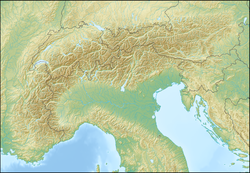1570 Ferrara earthquake
| Date | November 17, 1570 |
|---|---|
| Magnitude | 5.5 Ml |
| Epicenter | 44°49′01″N 11°37′59″E / 44.817°N 11.633°ECoordinates: 44°49′01″N 11°37′59″E / 44.817°N 11.633°E |
| Areas affected | Italy, Ferrara |
| Casualties | 171 |
The 1570 Ferrara earthquake struck the Italian city of Ferrara on November 16 and 17, 1570. After the initial shocks, an earthquake swarm continued for four years, with over 2000 aftershocks concentrated from November 1570 to February 1571.
The same area was struck, centuries later, by another major earthquake of comparable intensity.
The disaster destroyed half the city, permanently marked many of the buildings left standing, and directly contributed to – but was not the sole cause of – a long-term decline of the city lasting until the 19th century.
The earthquake caused the first documented episode of soil liquefaction in the Po Valley, and one of the oldest occurrences of the event known outside of paleoseismology. It led to the establishment of an earthquake observatory which published to very high regard, and the drafting of some of the first-known building designs based on a scientific seismic-resistant approach.
The Po Plain, which is a foreland basin formed by the downflexing of the crust by the loading of the Apennine thrust sheets, overlies and mainly conceals the active front of the Northern Apennines fold and thrust belt, across which there is about 1 mm per year of active shortening at present. Information from hydrocarbon exploration demonstrates that the area is underlain by a series of active thrust faults and related folds, some of which have been detected from anomalous drainage patterns. These blind thrust faults are roughly west-northwest–east-southeast-trending, parallel to the mountain front, and dip shallowly towards the south-southwest. The 1570 earthquake has been linked to movement on the outermost and northernmost of these thrusts.
Ferrara is located on the Emilian side of the Po Valley, an alluvial plain geologically quite stable since the Messinian age (7-5 mya). Small earthquakes are common, albeit not frequent, but rarely lead to considerable damage to the urban cityscape. Ferrara was the location for minor earthquakes in the four centuries before 1570, these events being recorded in the city archives with detailed descriptions of damage to buildings and depositions by witnesses.
...
Wikipedia

